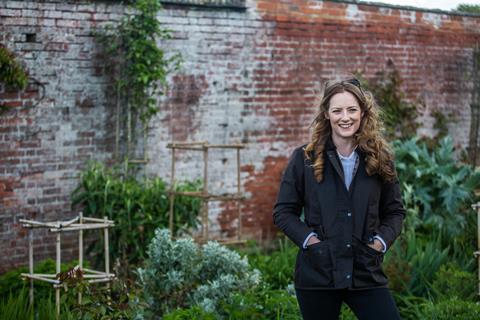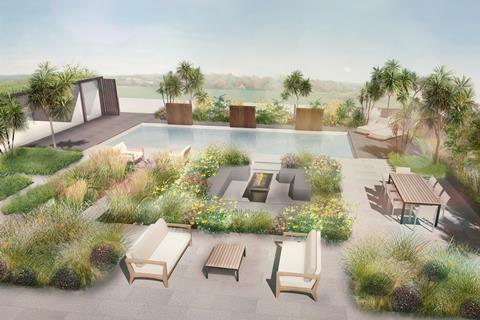Award-winning garden designer Grace Rogers shares her top tips for planting in June

“I fell in love with the clean lines, the classical geometry and the way lush flowerbeds created vibrant pools of colour and energy in a formal landscape. The sheer depth of the beautiful pinks and purples of the peonies. I was blown away,” Grace says, describing a turning point moment at the Chelsea Flower Show in 2009.
Grace, aged 23 at the time, stood looking at a show garden by Italian garden designer Luciano Giubbilei, entranced by the possibilities of garden design to express, evoke and transform. Here in front of her was a manifestation of her combined passions and skills; architecture meeting her love of flowers and the natural world. “But I never even knew this field of work existed! And had certainly never considered how perfectly it suited me.” From there on, she was hooked; a new commitment sprung up to pursue garden design that would take her on to win awards and set up her own successful business.
Discovering a calling
“It all started with architecture,” Grace shares. “I don’t know why, but I always wanted to be an architect when I was growing up. I was particularly keen on designing swimming pools!” This love of design stayed with her, leading her to study architecture at the University of Brighton, before going on to work for an architect in Hove for a year as a postgraduate.
“I worked hard – six days a week – and felt God saying I should save everything I earned. So I did, despite not knowing why.” It was then – as she saved week by week, in faith – that she began noticing flower shops; stopping, intrigued and enraptured, searching the window displays and wandering inside to absorb the scent, the colours and the atmosphere. “I saw a way of designing with nature, something I didn’t do in my architecture practice,” she shares. “I realised I wanted to study floristry. And, thanks to God, I had the money to do it.”
It was during her training as a florist that Grace stumbled across Giubbilei’s garden design at the Chelsea Flower Show. “Life went on – I completed my floristry course, got married and started working for a florist in Chelsea – but I couldn’t stop thinking about this beautiful garden I had seen, and wondering if I could ever create something like that.”
Grace loved her work as a florist but started sketching out ideas she had for gardens in her notebook or in her mind’s eye. “Then one day a customer walked into the florist shop where I worked and we got chatting. He was a garden designer!” The pair talked as Grace arranged his flowers; Grace sharing that she was intrigued by his profession. “You should do this,” he said over his shoulder as he left the shop. The customer’s name had sounded familiar to Grace, so she Googled: “Luciano garden design”. “And there he was! It had been none other than Luciano Giubbilei standing in my shop, telling me to become a garden designer!”
Grace recognises this encounter as a significant God moment in her life. “I’ve always known his hand is on my life, but it’s moments like this that you look back at and appreciate the beautiful tapestry he’s carefully creating.” She felt emboldened, assured that God, in his loving goodness, wanted this for her future; that it was he who had placed a passion for garden design on her heart. But another career step would require more money. Grace was set on going to Inchbald School of Design, where Luciano had studied – and the course was impossibly expensive. “As I prayed I felt God prompting me to Google the school again, so I did and discovered they had a competition for a full scholarship. It felt like a long shot, but I submitted my design – and, unexpectedly, I won!”

Collaborating with the greatest designer
Grace discovered a natural flair for garden design. She completed her training and set up her business, Grace Rogers Garden Design. “It’s happened very naturally,” she explains, “a steady knock-on effect of clients and opportunities. It feels like the fulfilling of a dream, finally doing what I was created to do.”
The business provides a full package – design, build and maintenance: “I love the variety: sketching designs at home and then seeing the drawing come to life as I project manage on site. It’s a beautiful process of getting to know clients and helping them to create their ‘happy place’.”
Many of the gardens Grace has designed and built in the last few years have been in central London, where precision and creativity are essential in utilising every square metre of space.
“I am constantly asking the greatest designer for his opinion. I know I need God’s input when creating something, so I’ll pray and ask him what the key is to unlock a project.” Grace recalls frequent moments when a design idea will come to her in an epiphany moment. “I know it’s God, not me, because of the intricacy of the idea; the extent to which it suits the client, or how it unexpectedly matches with the interior design of their house. I could not do it without him.”
Letting God lead
Two years ago, Grace moved to Kent with her young family, taking on a large, wild garden. “I’m paying attention to little corners when I have time. We started with rebuilding the vegetable beds and cleaning up the polytunnel last year. This year, I plan to focus on a few flower borders, but it’s hard to find time!
“There are moments when I hear God saying: ‘Don’t worry about the weeds in the garden, don’t bother with the washing up right now, just spend time with the kids,’ so I do. And I find freedom in leaving things – despite being someone who loves to have a tidy home and a beautiful garden – and prioritising getting down on the floor and playing with my kids.”
Grace’s work has come in God-ordained ebbs and flows; busy in easier seasons, and quieter when she’s needed to be present at home. “I know I need to trust him to design my day-to-day life, as well as my gardens. It’s a daily process of letting go and letting God lead.”
Planting advice
What are the best fruit and vegetables to plant in June?
If you haven’t already sown tomatoes, cucumbers and courgettes, these can be planted out in June in order to get a good harvest over summer. You should also be able to buy young plants if you haven’t sown seed earlier. Peas, beans and squash can be sown straight into the ground in June for a relatively quick harvest, as well as roots such as beetroot and radishes. It is also a good time to plant out autumn pumpkins, Brussels sprouts and broccoli. If you can get hold of some autumn-fruiting raspberry plants these can be planted into the garden for a later harvest, as well as a later-fruiting strawberry such as ‘Florence’.
What are the best flowers to plant in June?
Dahlias have such wow factor over summer with a huge variety of shapes, colours and sizes. They are also a good cut flower and can be mixed with easy annuals for pretty vase arrangements.
Strawflowers (Xerochrysum/Erochrysum bracteatu) work well in a border, but are very popular now in dried arrangements too. They hold their shape and colour well.
Cosmos, sweet peas, cornflower and nigella are easy annuals that give a lot of colour over a long period. Cut the flowers regularly for indoor vases and more will keep coming.
I love Japanese anemone for flowers well into autumn; it will survive well for a shadier spot and is a good plant for a single variety border.
What flowers blossom in June?
You will see plenty of impressive alliums, lupins, peonies and roses. More delicate transient flowers such as poppies will start dappling gardens and fields with colour, along with the longer-lasting verbena, salvias and flowering shrubs such as lavender. Climbers can also be outstanding in June, wisteria in particular.
What are the different types of soil and which flowers flourish in each soil?
Sand: Try planting Achillea, Echinops, bearded irises, ornamental grasses such as Pennisetum.
Clay: Astilbe, Astrantia, Thalictrum, Veronicastrum and Persicaria would give a lovely naturalistic look.
Loam: This type of soil has the best balance of clay, sand and silt so most plants will thrive. Avoid acid-loving plants.
Chalk: Trying planting foxgloves and delphiniums – these would mix well with thistles (Eryngium) and oriental poppies.
For more information visit gracerogersgardens.com
Words by Jane Knoop





























No comments yet